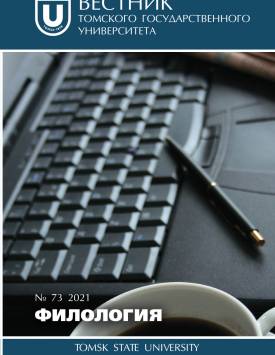Images of Japan in the Periodicals of the Russian Empire Regions at the Turn of the 20th Century: Translated Literature as an Imagological Tool
The article examines the functioning and role of images of Japan expressed in translated publications on the pages of regional Russian-language periodicals of the early 20th century. The aim of this article is to present an analysis of Japanese motifs shown via translated publications on the pages of regional Russian-language periodicals of the early 20th century. The research material is 45 texts presented in eight periodicals of the Southwestern Krai, Siberia, and the South of Russia. The methodological apparatus of the article is made up of research by leading imagologists, in particular, by the works of D. Schimmelpenninck, D.B. Pavlov, E.S. Zadvornaya, and others. It has been revealed that the images of Japan in periodicals are studied mainly in the perspective of imagological rhetoric due to its maximum adequacy to the cultural processes taking place in the reality. Thus, the material presented in the article is part of the same research paradigm, reflecting the complexity of this complex intercultural transfer. The imagological analysis of the presented texts showed the following results. The image of Japan is realized through three representational strategies: 1) The image of the fairytale Japan, publication of Japanese folklore translations. The image of the region is mythologized due to the appeal to its special traditions, originating from ancientry, famous in legend and alien to Europeans. 2) Historical, political and cross-cultural surveys about Japan, constructing the image of Japan by depicting the “characteristic features” of the people living there. The appearance, manners, and morals of the Japanese are reflected exclusively as “others” in separate cycles of texts specially dedicated to the “Japanese woman” and “Japanese children”. The image of the “Japanese man” is associated with a threat to the Western world. 3) Images of Japan in translated travelogues. In particular, in an abridged version of the famous novel Madame Chrysantheme by Pierre Loti. This author was one of the central mediators in the imagological discourse intended for readers of the Russian regional press at the beginning of the 20th century; most of the contemporary authors agreed with him or rejected his judgments when constructing the image of Japan. In the imaginative writings published on the pages of regional literary periodicals, a contradictory, but generally positive image of Japan is created. A characteristic feature associated with the imagological representation of Japan in translations is associated with its indirect specificity: without exception, all translations were made not from Japanese, but from European languages (French, German, Polish, English). It can be explained by the objective reason for not knowing the Japanese, but in fact it turns out that Russian reception is of an indirect nature and broadcasts mainly the Western idea of some distant culture. At the same time, the main figures are also quite recognizable, which served as guidelines for translators and acted as the authors of “belles-lettres” and “pictures” about Japan, as well as travel notes.
Keywords
Japan, translated literature, periodicals, Russian EmpireAuthors
| Name | Organization | |
| Nikonova Natalia Ye. | Tomsk State University | nikonat2002@yandex.ru |
| Abuduvaili Muaitair | Tomsk State University | hopeu123@bk.ru |
References

Images of Japan in the Periodicals of the Russian Empire Regions at the Turn of the 20th Century: Translated Literature as an Imagological Tool | Vestnik Tomskogo gosudarstvennogo universiteta. Filologiya – Tomsk State University Journal of Philology. 2021. № 73. DOI: 10.17223/19986645/73/13
